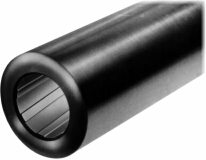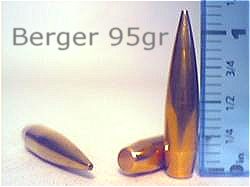|
|
|
Ten Twist Options for the 6BR
By Danny Reever
EDITOR'S CAUTION: Real-world experience has shown us that not all "10-twist" barrels are equal. Danny's Shilen barrel, as it turns out, was closer to a 1:9.8" twist. Also, we've seen that some barrels can deliver up to 130 fps more than other barrels--that's just the nature of the beast. Being mindful of that, be aware that the 95s may work in your 10-twist, but the stability can be borderline. For the Berger 95s, a safer bet is to go with a 1:9".
 Does your 1:8 twist barrel shoot in the teens at 100 yards? Are you seeing consistent half-inch groups at 200 yards in actual match conditions? If not, maybe it's time for you to consider a slower twist barrel. I went to a 1:10 twist and the results have far exceeded my expectations. The 10 twist, with Berger 90gr BTs and 95gr VLDs, is a winning combo from 100 to 600 yards. Does your 1:8 twist barrel shoot in the teens at 100 yards? Are you seeing consistent half-inch groups at 200 yards in actual match conditions? If not, maybe it's time for you to consider a slower twist barrel. I went to a 1:10 twist and the results have far exceeded my expectations. The 10 twist, with Berger 90gr BTs and 95gr VLDs, is a winning combo from 100 to 600 yards.
I'll concede that the vast majority of 6BR shooters campaigning their rifles beyond 500 yards are using 1:8 twist barrels. This twist rate is necessary to stablize the long 105-108gr bullets. However, when we look at the winning equipment lists for 100-200 yard Benchrest, we see mostly 1:13 and 1:14 barrels, with some 30BRs as slow as 1:17. In Palma competition, a ten twist barrel is as fast as you'll encounter, and best accuracy in a .308 rifle is normally achieved with a 1:11 or 1:12.
This gets one to thinking...would a 1:10 twist barrel offer the best of both worlds in the 6BR? You could run the nice custom 80-88gr flat-base bullets, and it would still be fast enough to stabilize the 90gr Berger BT and 95gr Berger VLD. By dropping down in bullet weight from the 105-108gr class you get a big gain in velocity with no increase in pressure. This means that a standard 6BR case could match the velocities of the 6 Improved cartridges, without the hassle of fire-forming or the expense of custom dies. Yes you give up a little BC, but, in return, you get significantly higher velocities. When you run the ballistics (assuming published BCs are correct), the 95gr Berger beats the 107gr SMK at 600 yards, because the Berger starts out 130 fps faster.
600yd Ballistics (from 100yd zero)
Berger 95gr VLD, 2980 fps (.524 BC); Drop: 56.6"; 10 mph Windage: 22.7"
Sierra 107gr SMK, 2850 fps (.527 BC); Drop: 78.4"; 10 mph Windage: 24.0"
 Comparing both vertical drop and windage out to 600 yards, the Berger 95 has the edge, at least the ballistics program says so. The wind drift at 600yds is about the same, but the Berger 95 drops a lot less, and when you figure in the inherent accuracy advantage of shorter bullets, the 1:10 really started to make sense. Moreover, the shorter bullets are easier to tune and they seem less sensitive to seating depth. So, I decided to go with 1:10. Now it takes some courage to break from the pack, but any good custom bullet maker will tell you a bullet will shoot better in the slowest twist barrel that will stabilize the round. That's why virtually all winning 6PPC barrels are 1:13, 1:14 or 1:15. A twist that is faster than necessary just creates more friction/drag in the barrel, which increases fouling and lowers velocity. Therefore, if you don't really need a 105+ grain bullet at 500 yards, you shouldn't shoot a 1:8. Comparing both vertical drop and windage out to 600 yards, the Berger 95 has the edge, at least the ballistics program says so. The wind drift at 600yds is about the same, but the Berger 95 drops a lot less, and when you figure in the inherent accuracy advantage of shorter bullets, the 1:10 really started to make sense. Moreover, the shorter bullets are easier to tune and they seem less sensitive to seating depth. So, I decided to go with 1:10. Now it takes some courage to break from the pack, but any good custom bullet maker will tell you a bullet will shoot better in the slowest twist barrel that will stabilize the round. That's why virtually all winning 6PPC barrels are 1:13, 1:14 or 1:15. A twist that is faster than necessary just creates more friction/drag in the barrel, which increases fouling and lowers velocity. Therefore, if you don't really need a 105+ grain bullet at 500 yards, you shouldn't shoot a 1:8.
But the question remained in the back of my mind, if the 1:10 worked so well on paper, why aren't more people shooting it? Well, I soon learned that it's simply because they are unwilling to try something new, or they haven't set up their rifles correctly, or they aren't driving the bullets fast enough. Does the 1:10 twist work in a 6BR? The answer is an emphatic "Yes" based on the results I've had so far.
With my 1:10 twist Shilen, I'm using the Berger 90 grain BT out to 300 meters and then the Berger 95gr VLDs beyond. Despite what you may hear, the Berger 95s stabilize just fine from a 1:10. What you have to remember is that the rpm a bullet turns is a function of BOTH the barrel twist and the speed with which it passes through the rifling. In other words, if you need a given number of revs to stablize a bullet you can achieve that two ways--either use a tighter twist or drive the bullet through the barrel faster. I think this is why the 95 stabilizes well. It is running a good 130fps faster than a 105gr bullet so it gets plenty of rpm even with a 1:10 twist.
So how does it shoot?
The 90s will shoot ones and twos at 100 yards, no joke! Of ALL the matches I've shot their AVERAGE group at 200 meters is .560". That again is no joke. At 500 meters the 95s are averaging 3.382" with a best group being a 1.220". Remember this is the average of fifteen matches--Not just one fluke group that I brag about. Shot in the wind/rain/heat etc. not on one calm day. In a Hart-actioned rifle with a Shilen 25" barrel, the load I'm using is 30 grains of Varget with a CCI BR4 primer for both bullets. The 90s are averaging 3040 fps and the 95s are averaging 2981 fps with no pressure signs. Work up to this though as your combination may vary.
Chambering for 1:10 Twist
My reamer has a .269" neck, this requires a minimal neck turn, just enough to clean it up. I wanted a tighter neck to hold those VLDs. I went with .060" freebore on the reamer that will allow you to seat everything from 68s to 107s into the lands. This reamer will do it all. If you plan on using the 68s don't exceed .080" or you may not have enough bullet in the case to touch the lands. I also went with a "no trim to length" so I could use the full long neck that Lapua gives you. That's 1.560" OAL. I've never had to trim back brass yet.
Call Dave Kiff at Pacific Tool & Gauge, (541) 826-5808, and talk to him about your reamer. If you want one like mine ask for the same as the one he made for Danny Reever.
If you have any more questions feel free to e-mail me at dreever@supernet.com
Copyright © 2004, 6mmBR.com, All Rights Reserved. No reproduction without advanced permission in writing.

|
|